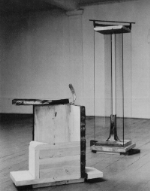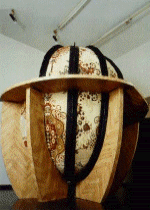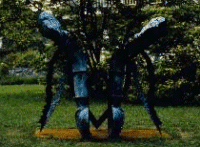|
|
 |

|

|

|
YOU AND STATUE I, YOU AND STATUE II, SOUL OF A GOBLET
Does making a sculpture mean filling space with Pygmalion's soul? I
s a sculpture a spatial object and an exploiter of spatial symbolism?
Is it an image which transforms viewing into seeing? Zidar's sculptures
seem like three-dimensional images and plastic forms of flat surfaces which,
in their structure and materials, are designed to display the rules of
the game of duality in the single and singularity (derived through the
third) in the double. The indica-ted horizontal layers of Angel's Gaze
are more evident in the sculpture's partner, i.e. Addition to the Statue,
and function as a commentary to a text. The mind is engaged and confirms
that the base (the pedestal), the central-transmission part (there is none)
and the upper part (the cover) really exist, but in this gravitational
order the supporting part, which has been signifying sculpture since Greek
and Roman temples, is transparent. It conjures illusions about the immaterial
and the abstinent and raises the problem of visualizing the invisible,
of what is inaccessible to one's vision and reason. Angel's Body, the glass
colum with a rationally formed structure, introduces an additional game
of transparency, namely looking through the object, which, at the mental
and optical level, enables the joining of the two physically disjunct
object. The two pairs of statues are built on countless contrasts, among
which transparency (glass) and opacity (wood, iron) of material and openness
(Angel's Body) and enclosure (Support for a Head) of volume are the most
elementary. However, they complement each other in turn as the contrasts
are used to establish a new order. Viewing the statue is complex since
it simultaneously enables and disenables seeing the first object, the second
object and reflection of the viewer. The Soul of a Goblet joins this duality
and prompts further ideals. The abundance of materials has been heavily
reduced. The compositional structure still tolerates the use of the labyrinth
metaphor (frequently applied in postmodernism) because the latter accommodates
the interwining of the duplication of the structure of an object from the
real word (broken glass), now used as part of piece of art, and mental
constructions which recall Tucker's reflections on the uselessness (i.e.
the lack of any usable value) of a sculpture. The compositional structure
imitates the way a film operates, whereby a conscious montage of sights
(sequences) is possible through the cleary evident compositional cuts.
LILIJANA STEPANČIČ
ILLUSION, KEY AND LOCK OF STATUE
The history of sculpture has provided us with the experience of the
fact that a sculpture evades reduction as soon as the latter tries to bring
it to its purity and literalness.
Whenever one views a sculpture, one wants to discover and reveal its essence.
The problem, which is in fact bound up with the definition of a modemistic
work of art and suggests its " incomprehensibility ", acts upon
us as a shock or trauma and resists the integration of work of art within
the symbolic universe. We are uncomfortable with the notion that the phenomenon
of a sculpture is something differentiateted and separated from its own
self. We want somehow to penetrate beyond a sculpture and therefore invest
pemianency and etemity in its appearance.We would like to penetrate to
the other side, beyond the image of sculpture.
The answer to this wish is utterly radical: there is nothing behind the
phenomenon of a sculpture. However, there is nothing wrong in our trying
to construct the other side of phenomenon; it would be wrong if we tried
to substantiate a sculpture, and to assign a certain basis to it. In that
case we would search for the etemal, transcendental world beyond the world
of appearances. We would get stuck at a substance which is not yet an object.
Substantiaton beyond the world of phenomena is therefore merely an empty
place. And that is the point: the empty place of the beyond we want to
get hold of and which becomes constitutive and indispensable in its emptiness.
The emptiness established by the inner distinction; of a phenomenon becomes
the place of a subject, and only then is the costitution of an observer
made possible. What is more, it is made possible only through an illusion
that there is something beyond.
Thus, the illusion opens the space where it is viable. It helps us to discover
that there is nothing beyond the phenomenon of a sculpture. If we were
without our awareness of this illusion, we would also be without our knowledge
and would therefore be unable to ' behold the world as the world of phenonema.
We would inevitably be beyond it by then.
Dušan ZIDAR